Panasonic FZ1000 vs FZ1000 II
The Panasonic Lumix DMC-FZ1000 and the Panasonic Lumix DC-FZ1000 II are two digital cameras that were announced, respectively, in June 2014 and February 2019. Both the FZ1000 and the FZ1000 II are fixed lens compact cameras that are equipped with an one-inch sensor. Both cameras offer a resolution of 20 megapixels.
Below is an overview of the main specs of the two cameras as a starting point for the comparison.

Check FZ1000 offers at
ebay.com

Check FZ1000 II price at
amazon.com
Going beyond this snapshot of core features and characteristics, what are the differences between the Panasonic Lumix DMC-FZ1000 and the Panasonic Lumix DC-FZ1000 II? Which one should you buy? Read on to find out how these two cameras compare with respect to their body size, their imaging sensors, their shooting features, their input-output connections, and their reception by expert reviewers.
Body comparison
The side-by-side display below illustrates the physical size and weight of the Panasonic FZ1000 and the Panasonic FZ1000 II. The two cameras are presented according to their relative size. Three consecutive views from the front, the top, and the rear side are shown. All width, height and depth dimensions are rounded to the nearest millimeter.
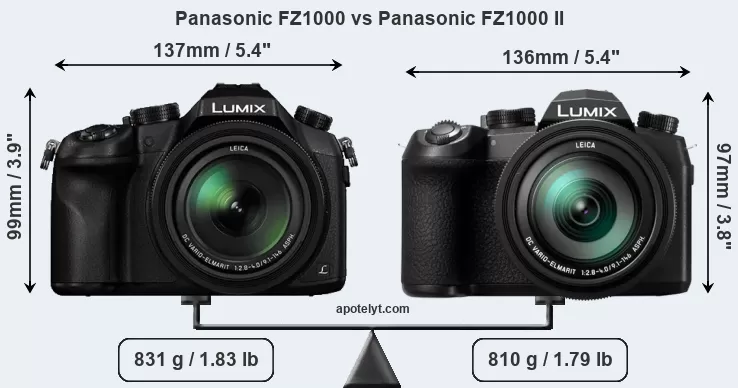
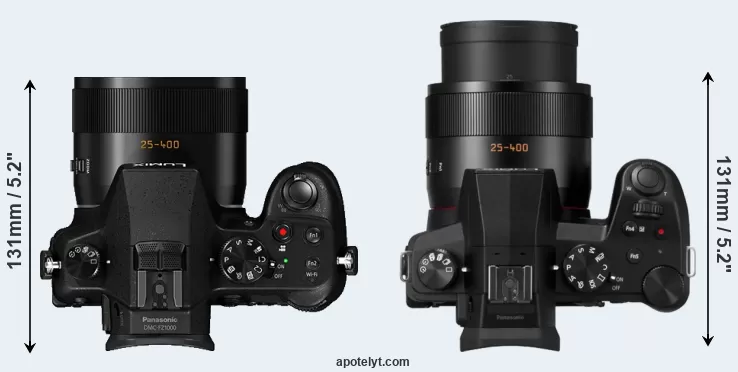
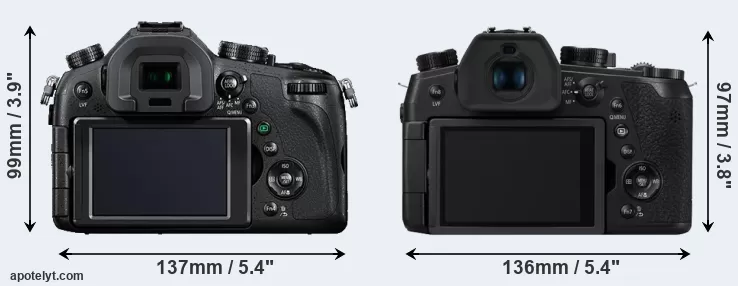
If the front view area (width x height) of the cameras is taken as an aggregate measure of their size, the Panasonic FZ1000 II is somewhat smaller (3 percent) than the Panasonic FZ1000. Moreover, the FZ1000 II is slightly lighter (3 percent) than the FZ1000. In this context, it is worth noting that neither the FZ1000 nor the FZ1000 II are weather-sealed.
The power pack in the FZ1000 II can be charged via the USB port, which can be very convenient when travelling.
The following table provides a synthesis of the main physical specifications of the two cameras and other similar ones. If you want to switch the focus of the display and review another camera pair, you can move across to the CAM-parator tool and choose from the broad selection of possible camera comparisons there.

| Camera Model |
Camera Width |
Camera Height |
Camera Depth |
Camera Weight |
Battery Life |
Weather Sealing |
Camera Launch |
Launch Price (USD) |
Street Price |
||
|---|---|---|---|---|---|---|---|---|---|---|---|
| 1. | Panasonic FZ1000 | 137 mm | 99 mm | 131 mm | 831 g | 360 | n | Jun 2014 | 899 | ebay.com | |
| 2. | Panasonic FZ1000 II | 136 mm | 97 mm | 131 mm | 810 g | 350 | n | Feb 2019 | 899 | amazon.com | |
| 3. | Canon G3 X | 123 mm | 77 mm | 105 mm | 733 g | 300 | Y | Jun 2015 | 999 | ebay.com | |
| 4. | Canon G5 X | 112 mm | 76 mm | 44 mm | 353 g | 210 | n | Oct 2015 | 799 | ebay.com | |
| 5. | Canon G7 X | 103 mm | 60 mm | 40 mm | 304 g | 210 | n | Sep 2014 | 699 | ebay.com | |
| 6. | Canon G9 X | 98 mm | 58 mm | 31 mm | 209 g | 220 | n | Oct 2015 | 529 | ebay.com | |
| 7. | Leica C-LUX | 113 mm | 67 mm | 46 mm | 340 g | 370 | n | Jun 2018 | 1,049 | ebay.com | |
| 8. | Panasonic FZ2500 | 138 mm | 102 mm | 135 mm | 915 g | 350 | n | Sep 2016 | 1,199 | amazon.com | |
| 9. | Panasonic LX100 | 115 mm | 66 mm | 55 mm | 393 g | 300 | n | Sep 2014 | 899 | ebay.com | |
| 10. | Panasonic LX100 II | 115 mm | 66 mm | 65 mm | 392 g | 300 | n | Aug 2018 | 999 | ebay.com | |
| 11. | Panasonic ZS200 | 111 mm | 65 mm | 45 mm | 340 g | 370 | n | Feb 2018 | 799 | amazon.com | |
| 12. | Sony RX100 II | 102 mm | 58 mm | 38 mm | 281 g | 350 | n | Jun 2013 | 749 | ebay.com | |
| 13. | Sony RX100 III | 102 mm | 58 mm | 41 mm | 290 g | 320 | n | May 2014 | 799 | ebay.com | |
| 14. | Sony RX100 IV | 102 mm | 58 mm | 41 mm | 298 g | 280 | n | Jun 2015 | 999 | ebay.com | |
| Note: Measurements and pricing do not include easily detachable parts, such as add-on or interchangeable lenses or optional viewfinders. | |||||||||||
The price is, of course, an important factor in any camera decision. The retail prices at the time of the camera’s release place the model in the market relative to other models in the producer’s line-up and the competition. The two cameras under review were launched at the same price and fall into the same market segment. Normally, street prices remain initially close to the MSRP, but after a couple of months, the first discounts appear. Later in the product cycle and, in particular, when the replacement model is about to appear, further discounting and stock clearance sales often push the camera price considerably down. Then, after the new model is out, very good deals can frequently be found on the pre-owned market.
Sensor comparison
The size of the sensor inside a digital camera is one of the key determinants of image quality. A large sensor will generally have larger individual pixels that offer better low-light sensitivity, provide wider dynamic range, and have richer color-depth than smaller pixels in a sensor of the same technological generation. Further, a large sensor camera will give the photographer additional creative options when using shallow depth-of-field to isolate a subject from its background. On the downside, larger sensors tend to be associated with larger, more expensive camera bodies and lenses.
Both cameras under consideration feature an one-inch sensor and have a format factor (sometimes also referred to as "crop factor") of 2.7. Within the spectrum of camera sensors, this places the review cameras among the medium-sized sensor cameras that aim to strike a balance between image quality and portability. Both cameras have a native aspect ratio (sensor width to sensor height) of 3:2.
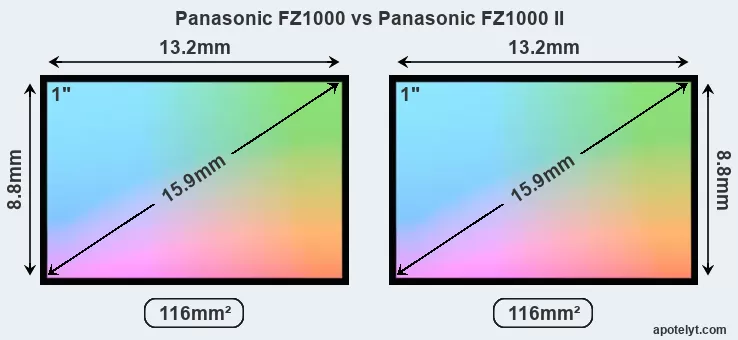
The two cameras under review do not only share the same sensor size, but also offer an identical resolution of 20 megapixels. This similarity in sensor specs implies that both the FZ1000 and the FZ1000 II have the same pixel density, as well as the same pixel size. It should, however, be noted that the FZ1000 II is much more recent (by 4 years and 8 months) than the FZ1000, and its sensor will have benefitted from technological advances during this time.
The Panasonic Lumix DMC-FZ1000 has a native sensitivity range from ISO 125 to ISO 12800, which can be extended to ISO 80-25600. The Panasonic Lumix DC-FZ1000 II offers exactly the same ISO settings.
In terms of underlying technology, the FZ1000 is build around a CMOS sensor, while the FZ1000 II uses a BSI-CMOS imager. Both cameras use a Bayer filter for capturing RGB colors on a square grid of photosensors. This arrangement is found in most digital cameras.
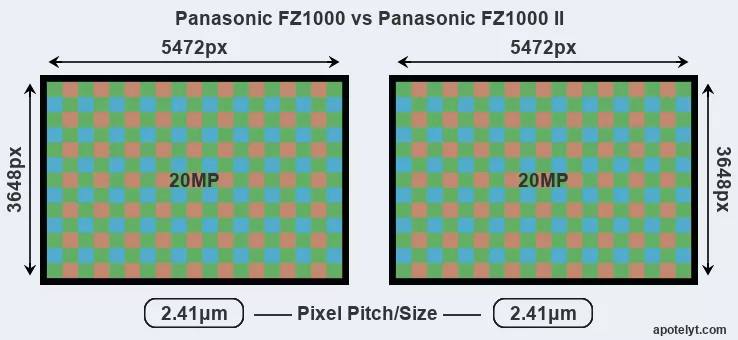
For many cameras, data on sensor performance has been reported by DXO Mark. This service is based on lab testing and assigns an overall score to each camera sensor, as well as ratings for dynamic range ("DXO Landscape"), color depth ("DXO Portrait"), and low-light sensitivity ("DXO Sports"). The following table provides an overview of the physical sensor characteristics, as well as the sensor quality measurements for a selection of comparators.

| Camera Model |
Sensor Class |
Resolution (MP) |
Horiz. Pixels |
Vert. Pixels |
Video Format |
DXO Portrait |
DXO Landscape |
DXO Sports |
DXO Overall |
||
|---|---|---|---|---|---|---|---|---|---|---|---|
| 1. | Panasonic FZ1000 | 1-inch | 20.0 | 5472 | 3648 | 4K/30p | 22.1 | 11.7 | 517 | 64 | |
| 2. | Panasonic FZ1000 II | 1-inch | 20.0 | 5472 | 3648 | 4K/30p | 22.1 | 12.4 | 546 | 65 | |
| 3. | Canon G3 X | 1-inch | 20.0 | 5472 | 3648 | 1080/60p | 21.4 | 12.3 | 521 | 63 | |
| 4. | Canon G5 X | 1-inch | 20.0 | 5472 | 3648 | 1080/60p | 21.4 | 12.3 | 471 | 62 | |
| 5. | Canon G7 X | 1-inch | 20.0 | 5472 | 3648 | 1080/60p | 23.0 | 12.7 | 556 | 71 | |
| 6. | Canon G9 X | 1-inch | 20.0 | 5472 | 3648 | 1080/60p | 21.5 | 12.3 | 495 | 63 | |
| 7. | Leica C-LUX | 1-inch | 20.0 | 5472 | 3648 | 4K/30p | 22.1 | 12.3 | 481 | 64 | |
| 8. | Panasonic FZ2500 | 1-inch | 20.0 | 5472 | 3648 | 4K/30p | 23.0 | 12.6 | 538 | 70 | |
| 9. | Panasonic LX100 | Four Thirds | 12.7 | 4112 | 3088 | 4K/30p | 22.3 | 12.5 | 553 | 67 | |
| 10. | Panasonic LX100 II | Four Thirds | 16.8 | 4736 | 3552 | 4K/30p | 22.8 | 12.7 | 979 | 72 | |
| 11. | Panasonic ZS200 | 1-inch | 20.0 | 5472 | 3648 | 4K/30p | 22.0 | 12.2 | 449 | 64 | |
| 12. | Sony RX100 II | 1-inch | 20.0 | 5472 | 3648 | 1080/60p | 22.5 | 12.4 | 483 | 67 | |
| 13. | Sony RX100 III | 1-inch | 20.0 | 5472 | 3648 | 1080/60p | 22.4 | 12.3 | 495 | 67 | |
| 14. | Sony RX100 IV | 1-inch | 20.0 | 5472 | 3648 | 4K/30p | 22.8 | 12.6 | 591 | 70 | |
| Note: DXO values in italics represent estimates based on sensor size and age. | |||||||||||
Many modern cameras are not only capable of taking still images, but also of capturing video footage. The two cameras under consideration both have sensors whose read-out speed is fast enough to capture moving pictures, and both provide the same movie specifications (4K/30p).
Feature comparison
Apart from body and sensor, cameras can and do differ across a range of features. The two cameras under review are similar with respect to both having an electronic viewfinder. However, the one in the FZ1000 II offers a slightly higher resolution than the one in the FZ1000 (2360k vs 2359k dots). The adjacent table lists some of the other core features of the Panasonic FZ1000 and Panasonic FZ1000 II along with similar information for a selection of comparators.

| Camera Model |
Viewfinder (Type or 000 dots) |
Control Panel (yes/no) |
LCD Specifications (inch/000 dots) |
LCD Attach- ment |
Touch Screen (yes/no) |
Max Shutter Speed * |
Max Shutter Flaps * |
Built-in Flash (yes/no) |
Built-in Image Stab |
||
|---|---|---|---|---|---|---|---|---|---|---|---|
| 1. | Panasonic FZ1000 | 2359 | n | 3.0 / 921 | swivel | n | 1/4000s | 12.0/s | Y | Y | |
| 2. | Panasonic FZ1000 II | 2360 | n | 3.0 / 1240 | swivel | Y | 1/4000s | 12.0/s | Y | Y | |
| 3. | Canon G3 X | optional | n | 3.2 / 1620 | tilting | Y | 1/2000s | 5.9/s | Y | Y | |
| 4. | Canon G5 X | 2360 | n | 3.0 / 1040 | swivel | Y | 1/2000s | 5.9/s | Y | Y | |
| 5. | Canon G7 X | none | n | 3.0 / 1040 | tilting | Y | 1/2000s | 6.5/s | Y | Y | |
| 6. | Canon G9 X | none | n | 3.0 / 1040 | fixed | Y | 1/2000s | 6.0/s | Y | Y | |
| 7. | Leica C-LUX | 2330 | n | 3.0 / 1240 | fixed | Y | 1/2000s | 10.0/s | Y | Y | |
| 8. | Panasonic FZ2500 | 2360 | n | 3.0 / 1040 | swivel | Y | 1/4000s | 12.0/s | Y | Y | |
| 9. | Panasonic LX100 | 2764 | n | 3.0 / 921 | fixed | n | 1/4000s | 11.0/s | n | Y | |
| 10. | Panasonic LX100 II | 2764 | n | 3.0 / 1240 | fixed | Y | 1/4000s | 11.0/s | n | Y | |
| 11. | Panasonic ZS200 | 2330 | n | 3.0 / 1240 | fixed | Y | 1/2000s | 10.0/s | Y | Y | |
| 12. | Sony RX100 II | optional | n | 3.0 / 1229 | tilting | n | 1/2000s | 10.0/s | Y | Y | |
| 13. | Sony RX100 III | 1440 | n | 3.0 / 1229 | tilting | n | 1/2000s | 10.0/s | Y | Y | |
| 14. | Sony RX100 IV | 2359 | n | 3.0 / 1228 | tilting | n | 1/2000s | 16.0/s | Y | Y | |
| Note: *) Information refers to the mechanical shutter, unless the camera only has an electronic one. | |||||||||||
One differentiating feature between the two cameras concerns the touch sensitivity of the rear screen. The FZ1000 II has a touchscreen, while the FZ1000 has a conventional panel. Touch control can be particularly helpful, for example, for setting the focus point.
Both cameras have an articulated rear screen that can be turned to be front-facing. This feature will be particularly appreciated by vloggers and photographers who are interested in taking selfies.The reported shutter speed information refers to the use of the mechanical shutter. Yet, some cameras only have an electronic shutter, while others have an electronic shutter in addition to a mechanical one. In fact, both cameras under consideration feature an electronic shutter, which makes completely silent shooting possible. However, this mode is less suitable for photographing moving objects (risk of rolling shutter) or shooting under artificial light sources (risk of flickering).
The Panasonic FZ1000 and the Panasonic FZ1000 II both have an intervalometer built-in. This enables the photographer to capture time lapse sequences, such as flower blooming, a sunset or moon rise, without purchasing an external camera trigger and related software.
Both the FZ1000 and the FZ1000 II have zoom lenses built in. Both optics have identical focal length range and aperture specifications (9.1-146mm f/2.8-4.0). Both cameras offer the same maximum aperture.
Concerning the storage of imaging data, both the FZ1000 and the FZ1000 II write their files to SDXC cards. Both cameras can use UHS-I cards, which provide for Ultra High Speed data transfer of up to 104 MB/s.
Connectivity comparison
For some imaging applications, the extent to which a camera can communicate with its environment can be an important aspect in the camera decision process. The table below provides an overview of the connectivity of the Panasonic Lumix DMC-FZ1000 and Panasonic Lumix DC-FZ1000 II and, in particular, the interfaces the cameras (and selected comparators) provide for accessory control and data transfer.

| Camera Model |
Hotshoe Port |
Internal Mic / Speaker |
Microphone Port |
Headphone Port |
HDMI Port |
USB Port |
WiFi Support |
NFC Support |
Bluetooth Support |
||
|---|---|---|---|---|---|---|---|---|---|---|---|
| 1. | Panasonic FZ1000 | Y | stereo / mono | Y | - | micro | 2.0 | Y | Y | - | |
| 2. | Panasonic FZ1000 II | Y | stereo / mono | Y | - | micro | 2.0 | Y | - | Y | |
| 3. | Canon G3 X | Y | stereo / mono | Y | Y | mini | 2.0 | Y | Y | - | |
| 4. | Canon G5 X | Y | stereo / mono | - | - | mini | 2.0 | Y | Y | - | |
| 5. | Canon G7 X | - | stereo / mono | - | - | micro | 2.0 | Y | Y | - | |
| 6. | Canon G9 X | - | stereo / mono | - | - | micro | 2.0 | Y | Y | - | |
| 7. | Leica C-LUX | - | stereo / mono | - | - | micro | 2.0 | Y | - | - | |
| 8. | Panasonic FZ2500 | Y | stereo / mono | Y | Y | micro | 2.0 | Y | - | - | |
| 9. | Panasonic LX100 | Y | stereo / mono | - | - | micro | 2.0 | Y | Y | - | |
| 10. | Panasonic LX100 II | Y | stereo / mono | - | - | micro | 2.0 | Y | - | Y | |
| 11. | Panasonic ZS200 | - | stereo / mono | - | - | micro | 2.0 | Y | - | Y | |
| 12. | Sony RX100 II | Y | stereo / mono | - | - | micro | 2.0 | Y | Y | - | |
| 13. | Sony RX100 III | - | stereo / mono | - | - | micro | 2.0 | Y | Y | - | |
| 14. | Sony RX100 IV | - | stereo / mono | - | - | micro | 2.0 | Y | Y | - |
The FZ1000 II is a recent model that features in the current product line-up of Panasonic. In contrast, the FZ1000 has been discontinued (but can be found pre-owned on ebay). As a replacement in the same line of cameras, the FZ1000 was succeeded by the Panasonic FZ2500. Further information on the features and operation of the FZ1000 and FZ1000 II can be found, respectively, in the Panasonic FZ1000 Manual (free pdf) or the online Panasonic FZ1000 II Manual.
Review summary
So what is the bottom line? Which of the two cameras – the Panasonic FZ1000 or the Panasonic FZ1000 II – has the upper hand? Is one clearly better than the other? The listing below highlights the relative strengths of the two models.
Arguments in favor of the Panasonic Lumix DMC-FZ1000:
- Easier device pairing: Supports NFC for fast wireless image transfer over short distances.
- More heavily discounted: Has been available for much longer (launched in June 2014).
Advantages of the Panasonic Lumix DC-FZ1000 II:
- More detailed LCD: Has a higher resolution rear screen (1240k vs 921k dots).
- Fewer buttons to press: Has a touchscreen to facilitate handling and shooting adjustments.
- Easier travel charging: Can be conveniently charged via its USB port.
- Easier wireless transfer: Supports Bluetooth for image sharing without cables.
- More modern: Reflects 4 years and 8 months of technical progress since the FZ1000 launch.
If the number of relative strengths (bullet points above) is taken as a guide, the FZ1000 II emerges as the winner of the match-up (5 : 2 points). However, the pertinence of the various camera strengths will differ across photographers, so that you might want to weigh individual camera traits according to their importance for your own imaging needs before making a camera decision. A professional wildlife photographer will view the differences between cameras in a way that diverges from the perspective of a family photog, and a person interested in architecture has distinct needs from a sports shooter. Hence, the decision which camera is best and worth buying is often a very personal one.
How about other alternatives? Do the specifications of the Panasonic FZ1000 and the Panasonic FZ1000 II place the cameras among the top in their class? Find out in the latest Best Superzoom Camera listing whether the two cameras rank among the cream of the crop.
In any case, while the specs-based evaluation of cameras can be instructive in revealing their potential as photographic tools, it says little about, for example, the shooting experience and imaging performance of the FZ1000 and the FZ1000 II in practical situations. User reviews that are available, for instance, at amazon can sometimes shed light on these issues, but such feedback is all too often partial, inconsistent, and inaccurate.
Expert reviews
This is where reviews by experts come in. The following table reports the overall ratings of the cameras as published by some of the major camera review sites (amateurphotographer [AP], cameralabs [CL], digitalcameraworld [DCW], dpreview [DPR], ephotozine [EPZ], photographyblog [PB]). As can be seen, the professional reviewers agree in many cases on the quality of different cameras, but sometimes their assessments diverge, reinforcing the earlier point that a camera decision is often a very personal choice.

| Camera Model |
AP score |
CL score |
DCW score |
DPR score |
EPZ score |
PB score |
Camera Launch |
Launch Price (USD) |
Street Price |
||
|---|---|---|---|---|---|---|---|---|---|---|---|
| 1. | Panasonic FZ1000 | 4/5 | + + | .. | 82/100 | 4.5/5 | 4.5/5 | Jun 2014 | 899 | ebay.com | |
| 2. | Panasonic FZ1000 II | .. | .. | .. | 83/100 | 4.5/5 | 4.5/5 | Feb 2019 | 899 | amazon.com | |
| 3. | Canon G3 X | 3.5/5 | + | .. | .. | 4.5/5 | 4/5 | Jun 2015 | 999 | ebay.com | |
| 4. | Canon G5 X | 5/5 | + + | .. | 78/100 | 4.5/5 | 4.5/5 | Oct 2015 | 799 | ebay.com | |
| 5. | Canon G7 X | 4/5 | + + | .. | 77/100 | 4.5/5 | 4.5/5 | Sep 2014 | 699 | ebay.com | |
| 6. | Canon G9 X | 3.5/5 | + + | .. | .. | 4.5/5 | 4.5/5 | Oct 2015 | 529 | ebay.com | |
| 7. | Leica C-LUX | .. | .. | 3.5/5 | .. | 4.5/5 | 4/5 | Jun 2018 | 1,049 | ebay.com | |
| 8. | Panasonic FZ2500 | .. | + | .. | 82/100 | 4.5/5 | 5/5 | Sep 2016 | 1,199 | amazon.com | |
| 9. | Panasonic LX100 | 5/5 | + + | .. | 85/100 | 5/5 | 5/5 | Sep 2014 | 899 | ebay.com | |
| 10. | Panasonic LX100 II | 4.5/5 | + | 4.2/5 | 82/100 | 4.5/5 | 4.5/5 | Aug 2018 | 999 | ebay.com | |
| 11. | Panasonic ZS200 | .. | + + | 4.5/5 | 81/100 | 4.5/5 | 4.5/5 | Feb 2018 | 799 | amazon.com | |
| 12. | Sony RX100 II | 5/5 | + + | .. | 79/100 | 4.5/5 | 4.5/5 | Jun 2013 | 749 | ebay.com | |
| 13. | Sony RX100 III | 5/5 | + + | .. | 82/100 | 4.5/5 | 5/5 | May 2014 | 799 | ebay.com | |
| 14. | Sony RX100 IV | 4.5/5 | + + | .. | 85/100 | 4/5 | 4.5/5 | Jun 2015 | 999 | ebay.com | |
| Note: (+ +) highly recommended; (+) recommended; (o) reviewed; (..) not available. | |||||||||||
Care should be taken when interpreting the review scores above, though. The assessments were made in relation to similar cameras of the same technological generation. Thus, a score needs to be put into the context of the launch date and the launch price of the camera, and comparisons of ratings among very different cameras or across long time periods have little meaning. Also, kindly note that some of the listed sites have over time developped their review approaches and their reporting style.

Check FZ1000 offers at
ebay.com

Check FZ1000 II price at
amazon.com
Other camera comparisons
Did this review help to inform your camera decision process? In case you would like to check on the differences and similarities of other camera models, just make your choice using the following search menu. There is also a set of direct links to comparison reviews that other users of the CAM-parator app explored.
- Canon 50D vs Panasonic FZ1000
- Canon 600D vs Panasonic FZ1000 II
- Canon T3i vs Panasonic FZ1000 II
- Fujifilm X-T5 vs Panasonic FZ1000 II
- Fujifilm X100V vs Panasonic FZ1000 II
- Leica C-LUX vs Panasonic FZ1000
- Nikon D1H vs Panasonic FZ1000 II
- Panasonic FZ1000 II vs Panasonic G9 II
- Panasonic FZ1000 vs Panasonic G3
- Panasonic FZ1000 vs Panasonic G6
- Panasonic FZ1000 vs Sony A7S
- Panasonic FZ1000 vs Sony NEX-5T
Specifications: Panasonic FZ1000 vs Panasonic FZ1000 II
Below is a side-by-side comparison of the specs of the two cameras to facilitate a quick review of their differences and common features.
| Camera Model | Panasonic FZ1000 | Panasonic FZ1000 II |
|---|---|---|
| Camera Type | Fixed lens compact camera | Fixed lens compact camera |
| Camera Lens | 25-400mm f/2.8-4.0 | 25-400mm f/2.8-4.0 |
| Launch Date | June 2014 | February 2019 |
| Launch Price | USD 899 | USD 899 |
| Sensor Specs | Panasonic FZ1000 | Panasonic FZ1000 II |
| Sensor Technology | CMOS | BSI-CMOS |
| Sensor Format | 1" Sensor | 1" Sensor |
| Sensor Size | 13.2 x 8.8 mm | 13.2 x 8.8 mm |
| Sensor Area | 116.16 mm2 | 116.16 mm2 |
| Sensor Diagonal | 15.9 mm | 15.9 mm |
| Crop Factor | 2.7x | 2.7x |
| Sensor Resolution | 20 Megapixels | 20 Megapixels |
| Image Resolution | 5472 x 3648 pixels | 5472 x 3648 pixels |
| Pixel Pitch | 2.41 μm | 2.41 μm |
| Pixel Density | 17.18 MP/cm2 | 17.18 MP/cm2 |
| Moiré control | Anti-Alias filter | Anti-Alias filter |
| Movie Capability | 4K/30p Video | 4K/30p Video |
| ISO Setting | 125 - 12,800 ISO | 125 - 12,800 ISO |
| ISO Boost | 80 - 25,600 ISO | 80 - 25,600 ISO |
| Image Processor | Venus | Venus |
| DXO Sensor Quality (score) | 64 | .. |
| DXO Color Depth (bits) | 22.1 | .. |
| DXO Dynamic Range (EV) | 11.7 | .. |
| DXO Low Light (ISO) | 517 | .. |
| Screen Specs | Panasonic FZ1000 | Panasonic FZ1000 II |
| Viewfinder Type | Electronic viewfinder | Electronic viewfinder |
| Viewfinder Field of View | 100% | 100% |
| Viewfinder Magnification | 0.70x | 0.70x |
| Viewfinder Resolution | 2359k dots | 2360k dots |
| LCD Framing | Live View | Live View |
| Rear LCD Size | 3.0inch | 3.0inch |
| LCD Resolution | 921k dots | 1240k dots |
| LCD Attachment | Swivel screen | Swivel screen |
| Touch Input | no Touchscreen | Touchscreen |
| Shooting Specs | Panasonic FZ1000 | Panasonic FZ1000 II |
| Focus System | Contrast-detect AF | Contrast-detect AF |
| Manual Focusing Aid | Focus Peaking | Focus Peaking |
| Max Shutter Speed (mechanical) | 1/4000s | 1/4000s |
| Continuous Shooting | 12 shutter flaps/s | 12 shutter flaps/s |
| Electronic Shutter | up to 1/16000s | up to 1/16000s |
| Time-Lapse Photography | Intervalometer built-in | Intervalometer built-in |
| Fill Flash | Built-in Flash | Built-in Flash |
| Storage Medium | SDXC cards | SDXC cards |
| Single or Dual Card Slots | Single card slot | Single card slot |
| UHS card support | UHS-I | UHS-I |
| Connectivity Specs | Panasonic FZ1000 | Panasonic FZ1000 II |
| External Flash | Hotshoe | Hotshoe |
| USB Connector | USB 2.0 | USB 2.0 |
| HDMI Port | micro HDMI | micro HDMI |
| Microphone Port | External MIC port | External MIC port |
| Wifi Support | Wifi built-in | Wifi built-in |
| Near-Field Communication | NFC built-in | no NFC |
| Bluetooth Support | no Bluetooth | Bluetooth built-in |
| Body Specs | Panasonic FZ1000 | Panasonic FZ1000 II |
| Battery Type | Panasonic DMW-BLC12 | Panasonic DMW-BLC12 |
| Battery Life (CIPA) | 360 shots per charge | 350 shots per charge |
| In-Camera Charging | no USB charging | USB charging |
| Body Dimensions |
137 x 99 x 131 mm (5.4 x 3.9 x 5.2 in) |
136 x 97 x 131 mm (5.4 x 3.8 x 5.2 in) |
| Camera Weight | 831 g (29.3 oz) | 810 g (28.6 oz) |

Check FZ1000 offers at
ebay.com

Check FZ1000 II price at
amazon.com
Did you notice an error on this page? If so, please get in touch, so that we can correct the information.

